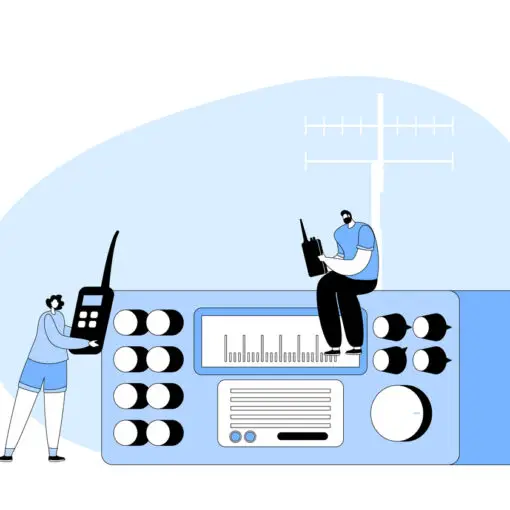Ham radio, also known as amateur radio, offers a world of communication possibilities for enthusiasts around the globe. Whether you’re new to the hobby or an experienced operator, understanding the essential procedures is key.

Operators must follow specific protocols, like identifying themselves with their call sign every ten minutes and at the end of a conversation. This rule keeps communication organized and compliant with regulations.
There are also advanced techniques for engaging in complex activities such as satellite communication and emergency preparedness, making ham radio a versatile tool.
Ham radio operators often discuss a wide range of topics, from equipment basics to best practices. Whether discussing antenna setup or handling emergency communications, operators share knowledge to improve their skill set and enjoy the hobby even more.
Key Takeaways
- Proper procedures are crucial for efficient communication.
- Identifying with call signs is a regulatory requirement.
- Ham radio includes advanced techniques and emergency uses.
Basic Operating Techniques

To effectively operate a ham radio, it is crucial to understand the specific frequencies and bands used, proper identification protocols like call signs, how to initiate contact by calling CQ, and appropriate voice and language use.
Understanding Frequencies and Bands
Frequencies and bands are the backbone of ham radio communication.
Operators use specific frequency ranges called bands, which are allocated by regulatory bodies. These bands include HF (High Frequency), VHF (Very High Frequency), and UHF (Ultra High Frequency).
Knowing which frequency to use is important. HF bands are great for long-distance communication, while VHF and UHF bands are suited for local communication.
Operators must also be aware of band plans, which outline frequency allocations for different types of communication. Using the correct frequencies ensures that operators communicate effectively without causing interference.
Call Signs and Identification
Call signs are unique identifiers assigned to each ham radio operator. They are essential for identifying oneself and ensuring clear communication.
A call sign typically includes letters and numbers, structured according to regional regulations.
Operators must announce their call sign at the beginning and end of each transmission. This practice helps maintain a clear record of communications and adheres to legal requirements.
Proper identification is crucial to establishing credibility and ensuring that other operators know who they are communicating with. Misidentifying or failing to use a call sign can lead to confusion and regulatory issues.
Initiating Contact and Calling CQ
To initiate contact, operators often use the term “CQ,” which signals they are seeking a conversation.
Calling CQ generally involves repeating “CQ” followed by the operator’s call sign. This process is vital for finding other operators on the same frequency.
When calling CQ, it’s important to use a clear and steady voice.
After sending a CQ call, the operator listens for a response. If another operator answers, they exchange call signs to confirm contact.
The initial exchange may include signal reports and locations. Using CQ effectively helps operators connect with others and establish successful communications.
Voice and Language Use
Using proper voice techniques and language is vital for clear communication.
Operators should speak slowly and clearly, ensuring that their message is understood.
It’s recommended to use standard phonetics to spell out difficult words or call signs.
Phonetics helps reduce misunderstandings, especially when signals are weak or noisy. For example, say “Alpha” for “A,” “Bravo” for “B,” and so on.
Language should be simple and concise. Avoid jargon or complicated terms that may confuse other operators.
Clear and precise communication is key to effective ham radio operation, helping to foster cooperation and understanding among operators.
Advanced Operating Procedures
Mastering advanced operating procedures helps amateur radio operators optimize their communication and maintain proper etiquette. Knowledge of both HF operations and VHF/UHF and repeater use is essential.
HF Operations and Etiquette
In High Frequency (HF) bands, operators engage in long-distance communication.
Key practices include maintaining a clear signal, avoiding interference, and being respectful to other users.
Using Morse Code (CW) and Digital Modes like RTTY and Packet allows for efficient and precise communication.
Operators must also understand pile-ups, where multiple operators attempt to contact a single station.
Effective techniques involve listening carefully, calling at the right time, and using concise, standardized phrases.
Courtesy is paramount; operators should avoid interrupting ongoing conversations and adhere to designated band plans.
VHF/UHF and Repeater Use
Very High Frequency (VHF) and Ultra High Frequency (UHF) operations often involve repeaters, which extend communication range.
Proper repeater use includes identifying oneself with a callsign, pausing between transmissions, and respecting the repeater’s purpose.
Important skills include operating in Digital Modes and understanding Packet Radio, which is used for digital data communication over ham radio frequencies.
On repeaters, maintaining clear, concise communication is crucial.
Operators should monitor for ongoing conversations and use standard procedures to join or leave a discussion.
Familiarity with local repeater etiquette ensures smooth and efficient use.
Emergency Communications
Ham radio plays a crucial role during emergencies, providing reliable communication when other services fail. In these situations, managing priority traffic handling, following net control and emergency protocols, and setting up for emergency situations are key responsibilities.
Priority Traffic Handling
Handling priority traffic is essential in emergencies.
Priority traffic includes urgent messages that must be transmitted immediately, such as rescue requests or important updates.
Operators need to identify and prioritize these messages without delay.
This helps ensure that critical information reaches its destination swiftly, aiding in effective response efforts.
Operators should maintain a clear log of all traffic, marking messages as Emergency (EMER), Priority (PRI), or Routine (RTN) to determine the order of handling.
This system helps in organizing communications and avoiding delays.
Net Control and Emergency Protocols
The Net Control Station (NCS) manages the flow of communications within a network during emergencies.
The NCS assigns specific frequencies for different types of traffic. It ensures orderly communication and minimizes interference.
The NCS follows a strict protocol, giving clear instructions and maintaining discipline among operators.
They announce the net’s status, such as “This is a directed net” or “This is a free net,” guiding operators on how to proceed.
Maintaining a calm and authoritative tone is vital for efficiency.
Setting Up for Emergency Situations
Setting up for emergencies involves preparing equipment and ensuring readiness.
Operators should have a go-kit ready, including radios, batteries, antennas, and other essential gear.
It is important to test all equipment regularly to confirm functionality.
During a disaster, locating a safe and strategic position for setting up is important.
Operators often work with local authorities to find suitable locations. Setting up beacons can aid in guiding and coordinating efforts.
Establishing a reliable communication network early in an emergency can significantly impact the response effectiveness.
Equipment and Antenna Basics
This section explains how to choose the right ham radio equipment, various antenna types, tuning methods, and maintenance practices. It provides practical tips to ensure smooth operation.
Choosing the Right Equipment
Selecting the right equipment begins with a reliable transceiver.
A transceiver, which combines a transmitter and a receiver, is essential. Look for models that cover the desired frequency ranges and offer good sensitivity and selectivity.
A good microphone is also crucial. It ensures clear communication. Handheld or mounted options are available based on user preference.
For portable operations, a dual-band (VHF/UHF) handheld radio is a versatile choice, as it covers common frequency bands used in ham radio.
Don’t forget to check if it comes with additional features like weather alerts or digital modes.
Antenna Types and Tuning
Antenna types vary widely based on usage needs.
Vertical antennas are easy to install and ideal for general use. Dipole antennas are simple, effective, and can be made from wire.
Yagi antennas focus signal strength in a specific direction, which is useful for long-distance communication. For mobile operations, mag-mount antennas provide flexibility and ease of installation.
Proper tuning of the antenna is key for efficient operation.
An SWR (Standing Wave Ratio) meter can help fine-tune the antenna to get the best signal. Ensuring the antenna is correctly tuned minimizes signal loss and maximizes transmission power.
Maintenance and Troubleshooting
Regular maintenance ensures long-term performance.
Keep equipment clean and dry, and inspect connections regularly. Replace any worn-out cables to prevent signal loss.
Troubleshooting common issues involves checking power supply, ensuring the antenna is correctly tuned, and verifying all connections are secure.
Keep an extra set of cables and battery packs handy to avoid downtime during critical operations.
For more tips and practical advice on ham radio setups and operations, check out these resources on best practices for ham radio and cheat sheets for beginner operators.
Frequently Asked Questions
This section covers common questions related to ham radio procedures, providing straightforward and clear answers on various topics like contact initiation, proper etiquette, conversation flows, and communication techniques.
What are the basic steps for initiating contact on ham radio?
To start a contact, first find an open frequency.
Listen for a while to ensure it’s not in use. Identify yourself by calling CQ or responding to someone else’s CQ call. Provide your call sign clearly.
What is the proper etiquette for conducting a ham radio check?
When doing a radio check, ask politely if the frequency is in use. If not, state your call sign and ask for a signal report. Keep it brief and thank those who respond with feedback.
Can you provide an example of a typical ham radio conversation flow?
A typical conversation might start with a CQ call, followed by exchanging call signs and signal reports.
Then, operators might discuss their equipment or recent activities. Finally, they confirm the end of the contact with a sign-off phrase like “73.”
What should one do before calling CQ on ham radio?
Before calling CQ, listen to the frequency to ensure it’s not busy.
Check for any ongoing conversations. Make sure your equipment is set to the correct mode and power level. Identify yourself briefly before making a call.
How does one conclude a ham radio communication effectively?
To end a communication, thank the other operator for the contact.
Exchange final signal reports if necessary. Use a sign-off like “73,” which means best regards. Clearly state your call sign before ending the transmission.
What is considered the golden rule in ham radio communications?
The golden rule is to always be courteous and respectful. Follow established rules and guidelines to ensure smooth and enjoyable communication for all operators.
Respect others’ use of the frequency and avoid interrupting ongoing conversations.





